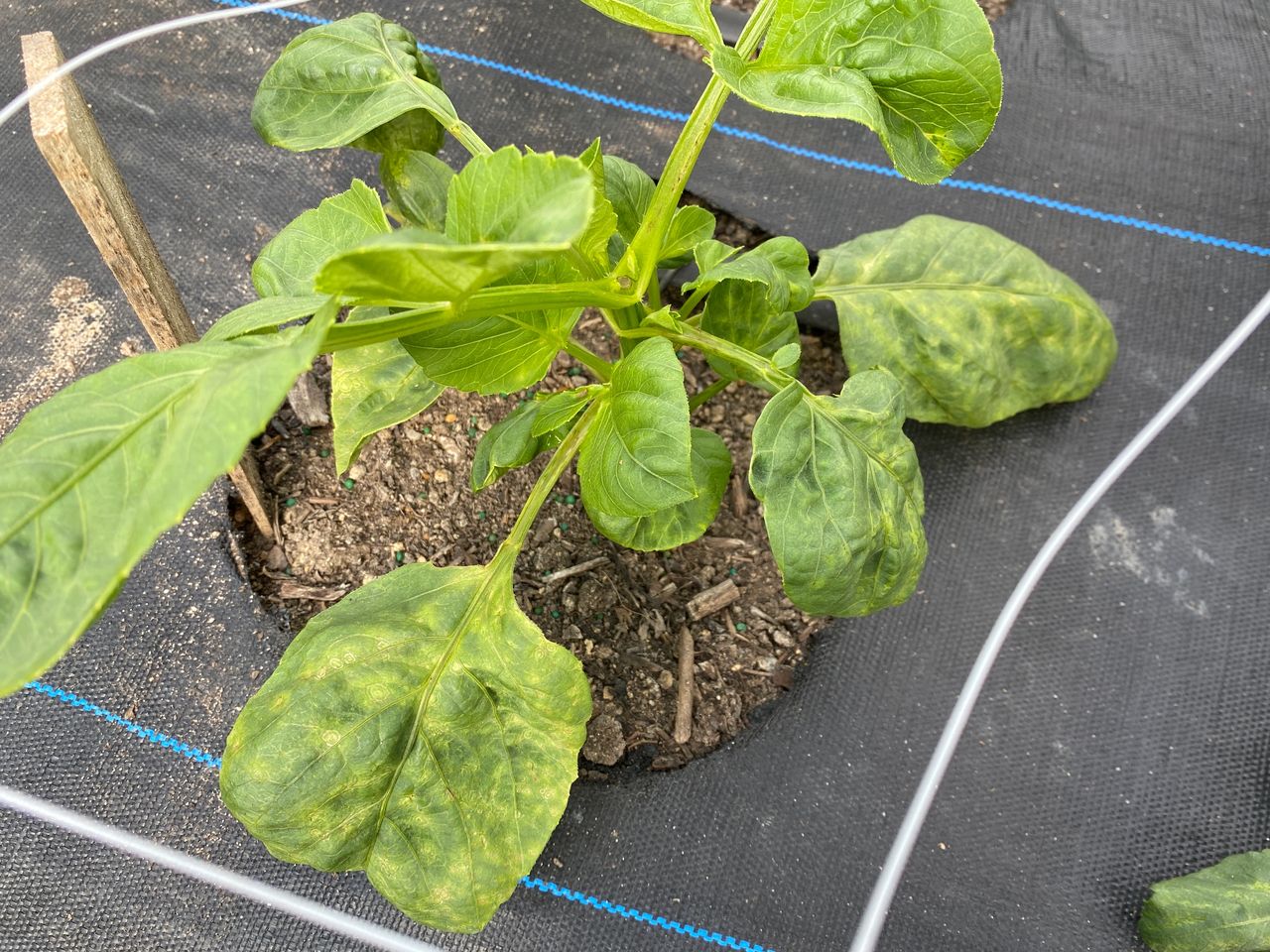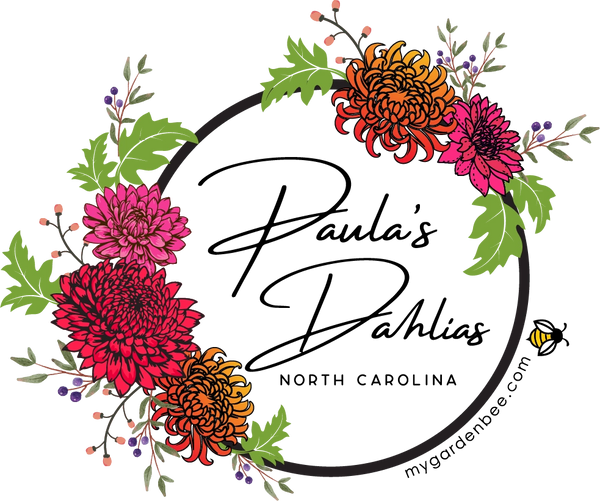
Dahlia Viruses. How to have a clean garden.
There are several viruses that affect dahlias. There is the Dahlia Mosaic Virus (DMV), Dahlia Common Mosaic Virus (DCMV), Cucumber Mosaic Virus (CMV), Tomato Spotted Wilt Virus (TSWV), Impatiens Necrotic Spot Virus (INSV), and Tobacco Streak Virus (TSV). Once the dahlia is infected, there is no cure. CMV and DMV are spread by aphids. INSV, TSV, and TSWV are spread by thrips. The American Dahlia Society (ADS) has more information about dahlia viruses on their website at dahlia.org.

Dr. Hannu Pappu, a Washington State University virologist, heads a virus project at the Washington State University and works closely with the American Dahlia Society. He researches the identification, control, and elimination of dahlia virus diseases. I have heard Dr. Pappu speak several times. The ADS has a 2015 brochure called ”How Virus Effects Dahlia Foliage”. On their website, under the Research tab, click Virus, Understanding Virus in Dahlias, and Virus Documentation Index, you will see this under 2015.
One thing we can do per the ADS is “when in doubt, throw out”. If a dahlia looks sick, it is probably sick so dig it up and throw it away in a trash bag. The sources of virus infection are from infected tubers, dahlia plants, and cuttings. Viruses are spread by insects like thrips and aphids; however, they are also spread by us by the tools that we use such as pruners, cutting scissors, loppers, shovels, etc.
Virus usually looks like yellowing on the leaf, yellow spots, light green/dark green spots, twisted leaves, etc. There is chlorosis which is the reduction or loss of the normal green color of leaves especially along the leaf veins. It is important that we only keep our healthiest looking plants. If the tuber you planted had a virus, it may show up immediately once the dahlia starts to grow. If the virus was spread by aphids or thrips, it will take longer to show up in the plant. It may be the middle of the dahlia season before you see any signs of virus.
Dahlias can be asymptomatic. They may not show any signs of virus as the virus level is low and the dahlia is able to fight back. It may be low enough that insects cannot pick it up. However, the virus is carried through to the tuber, so it is important to disinfect your tools between dividing each dahlia clump.
Once the dahlia shows symptoms, the virus load is high. Thrips and aphids can spread it to more dahlias, so it is important to inspect your dahlias often. This is best to do on a cloudy day and the symptoms on the leaves will stand out more in the shade than in full sun. If you see an odd-looking dahlia, remove it from your garden, disinfect your tools, wash your hands, and throw the dahlia in the trash. Do not compost it. Depending on the level of virus in the dahlia, it may or may not stand out to you as a dahlia can be asymptomatic.

I was walking through my dahlia garden and I saw a diseased dahlia in the summer several years ago. I had purchased the tuber from a U.S. grower. I planted it at the end of May. It did not show any signs of virus when it first sprouted. I immediately removed it from my garden and placed it in a trash bag. I disinfected my trowel and washed my hands. It can be so hard to throw a dahlia away especially if it is one you really wanted; however, you must remove the dahlia from your garden so that no other dahlias are affected. The only way we can have a clean dahlia garden is to remove dahlias with virus and disinfect our tools. I disinfect my cutting shears every day that I am in the dahlia garden. Also, it can be hard to see a virus dahlia in the sunlight. The patterns of a virus on the leaves will stand out in the shade so inspect your dahlia garden on cloudy days.
The American Dahlia Society has a 2019 brochure called “Virus in Dahlias – Be Part of the Solution.” They recommend a 10% bleach solution. You can follow with a soapy water rinse using Dawn dish detergent. You need to dip your tools in the bleach solution for a few minutes.
We need to try to control aphids and thrips in our dahlia garden. Early young plants are more susceptible, where older mature plants can form resistance. We need to use a 10% bleach solution to disinfect our tools that we use in our dahlia garden. You can also use Virkon S tablets. Virkon S is a disinfectant that kills viruses and bacteria. It is usually used for cleaning and disinfecting hard surfaces in livestock production facilities and transportation facilities. Ten minutes is the maximum contact time. I purchase Virkon S tablets online at Amazon. (I may earn a small commission over time from qualifying purchases as an Amazon Associate).

You can use the blue or yellow sticky sheets that you place down in the canopy of your plants to kill any thrips. Make sure you place them deep in the canopy of your dahlias so you do not catch small beneficial insects. There are products like Neem Oil and Spinosad that are OMRI certified. You could purchase and release predatory mites that feed on thrips. You can also purchase lady bugs, parasitic wasps, or lacewing larvae to release in your dahlia garden. The minute pirate bug (Orius insidiosus) is a predator for thrips. You could plant the ornamental pepper plant “Purple Flash” around your dahlias as it provides a habitat for the minute pirate bug. The minute pirate bug loves spider mites and thrips, but they also eat aphids, white flies, and other insect and mite eggs.

If you go to the ADS website (dahlia.org), under Research, Virus, Understanding Virus in Dahlias, and Virus Documentation Index, you will see great information about understanding viruses. There is Agdia, Inc. that is located in Indiana that does offer dahlia home testing kits. It seems to be best to test in the fall with mature leaves. Early young leaves may not have a high enough virus level to be able to detect the virus. I have tried some home testing; however, it can be expensive and not feasible to test all your dahlias if you grow a lot of dahlias. My home testing results came back negative. You are only testing a small quarter size leaf sample.
There are photos of dahlia virus symptoms by Linda Taylor who is on the ADS virus team. You can find it on the ADS virus documentation index.
If the dahlia does not have yellowing down the veins but has yellowing leaves and you think it may be a nutritional problem, you could give the dahlia some Epsom salt and see if the condition improves within the next week. You could mix one or two tablespoons of Epsom salt per gallon of water. Epsom salts contain micronutrients and seems to help some plants like roses, tomatoes, and peppers. It can help you have greener foliage and bigger vegetables or flowers as it contains magnesium and Sulphur. If you see the yellowing of the leaves, it can be a magnesium deficiency. It may work faster if you mix one or two tablespoons of Epsom salt in a gallon of water and spray it directly on the leaves so that it will be absorbed faster into the plant system and pour some into the soil around the dahlia. It is best to do a foliar spray in the evening, early morning, or on a cloudy day. You should see an improvement in the dahlia within the week if it was a magnesium deficiency. It is always best to have your soil tested. For general use, one tablespoon of Epsom salt per one gallon of water is enough to will help plants that need some magnesium. Two tablespoons per gallon would be if the plant looks really nutrient deficient. Magnesium is essential for photosynthesis so it help plants to absorb the necessary nutrients it needs. Some people apply it once a month during the growing season as it can help produce larger and more vibrant blooms.
It seems like we will always have viruses floating around from time to time. Some dahlias have viruses but may not show symptoms because they are fighting off the virus. We all want a “clean” dahlia garden. When you read all the dahlia virus articles, it does seem like an impossible task. We just need to disinfect our tools and remove any dahlia plants that show symptoms of a dahlia virus. We need to make sure our plants are healthy so they can resist these viruses. You are not alone when you find a dahlia with a virus in your garden as we are all fighting this issue. Make sure you keep healthy strong dahlia plants each year. Do not keep weak dahlia plants. We need to focus on the dahlias that are healthy and strong and fighting the virus. As long as we keep our dahlias fertilized, keep them happy in well-drained soil, and try to keep pests away, any odd-looking dahlia should stand out for you to dispose of to a trash bag.
In closing, disinfect your tools and become knowledgeable about dahlia viruses and what they look like so you can remove any dahlias showing virus symptoms. I do the best I can to have a "clean" dahlia garden.

